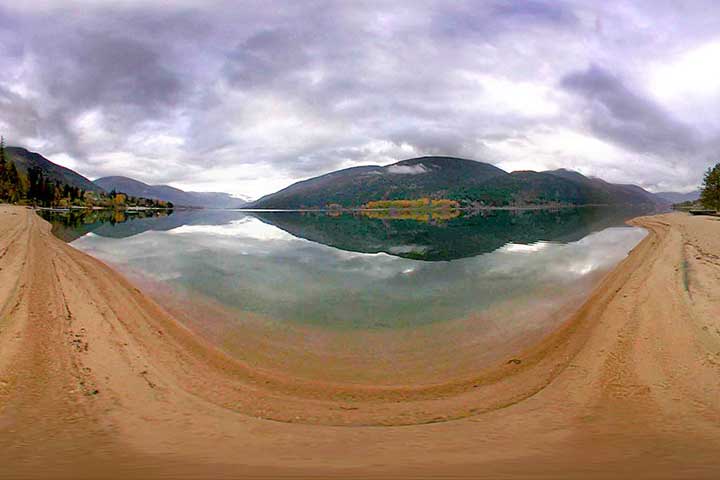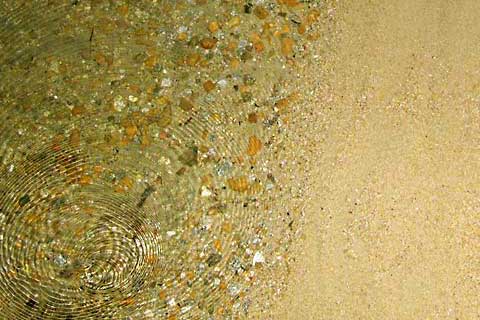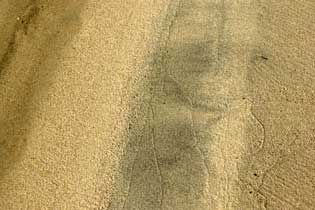Sorting of sand
Sand is sorted by waves. Big waves deposit large grains along the water’s edge; little waves deposit little grains. When the lake level is dropping, parallel bands of uniformly-sized sand grains reveal the recent wave climatology of the lake: storms and calm, even the cyclic variation of wind and wave from day to night. Mind you, while this pattern is often seen, it does depend upon the sand already present. The waves cannot sort that which wasn’t there to begin with.
I could get away with making simple statements such as those, above, because I wasn’t specific as to what was meant by a big or small wave. As soon as one tries to pin these ideas down, the situation gets much more complex and uncertain. The fundamental issue is that to move a grain of sand, the water has to lift and support it for a while: the water must have upward velocities that are greater than the terminal fall velocity of the sand grain (which, in turn depends upon the composition and shape of the grain). The velocities generated in a wave depend upon wavelength, wave amplitude, beach slope, and the nature of the breakers produced as the wave washes up on the beach. Suffice to observe, the largest vertical velocities will generally be in the region where the wave breaks. As the wave washes up on the beach (the swash), the velocities rapidly decrease, so only smaller sand grains can be transported into this region. The gentler backwash will transport some, but not all, of that fine sand (and any silt present) back down and out into the lake, but usually isn’t strong enough to move the courser grains. The general result is that the largest grains collect just to the water side of the shore, while finer sand is deposited to either side. Of course, what is meant by fine and course sand will change with the size of the wave, and so the result changes from minute to minute and day to day.
Suffice to say, the waves do sort the sand along the slope of the beach.
Further, as the waves on one portion of a beach are often systematically different than those on another, the character of the beach can change along its length. This is the case at Queen’s Bay.
 Looking like annular rings, bands of course and fine sand reveal the daily variation of wind and waves as the Lake drops. The course sand is laid down during the day when the lake is rough, and the fine sand during the night when the lake is calmer. This autumnal view is from Shannon Point looking across to Troup.
Looking like annular rings, bands of course and fine sand reveal the daily variation of wind and waves as the Lake drops. The course sand is laid down during the day when the lake is rough, and the fine sand during the night when the lake is calmer. This autumnal view is from Shannon Point looking across to Troup.
 Wave sorting There is often a change in the average size of sand across the water’s edge, with the finer sand being the only thing which could be transported up the slope with the swash.
Wave sorting There is often a change in the average size of sand across the water’s edge, with the finer sand being the only thing which could be transported up the slope with the swash.
 Fine sorting Sorting by the waves can make exceedingly fine distinctions, as the moving water lifts and moves some grains of sand, while leaving others. As the water level in the Lake goes down, bands of finely sorted sand are left along the edge of the beach.
Fine sorting Sorting by the waves can make exceedingly fine distinctions, as the moving water lifts and moves some grains of sand, while leaving others. As the water level in the Lake goes down, bands of finely sorted sand are left along the edge of the beach.
In this picture, one can also see older swash marks.
 Pebbles or sand There is a fairly systematic difference between the beaches along the Main Lake, and those along the West Arm. While each region has variability, along the Main Lake the beaches are often formed from gravel or pebbles (left), while along the West Arm sand is the norm (right). The creek sources of beach material are essentially the same for each region, so a different supply is unlikely to account for the differences.
Pebbles or sand There is a fairly systematic difference between the beaches along the Main Lake, and those along the West Arm. While each region has variability, along the Main Lake the beaches are often formed from gravel or pebbles (left), while along the West Arm sand is the norm (right). The creek sources of beach material are essentially the same for each region, so a different supply is unlikely to account for the differences.
It is true that the Main Lake gets bigger waves, a consequence of the generally greater fetch. Yet, even sheltered beaches (such as that at Sawmill Cove), have pebbly beaches, so the differences in beaches is unlikely to depend entirely on the differences in waves. Rather, I expect the answer depends upon the slope of the shorelines.
The Main Lake is deep; even more to the point, the considerable depths are achieved close to the shore, so the shore is steep. The West Arm is shallow; while there are a few deep spots, the shore is gently sloping. Sand which is moved off shore by the waves on the West Arm is not so far below the surface of the water that it cannot be moved back up the beach by subsequent waves. But, on the Main Lake, sand which is moved off shore, settles to depths which are out of reach of subsequent waves, and the material is lost to the depths. Pebbles and cobble are not as easily moved by the waves and so, being left behind, make up the Main Lake beaches.
![]()